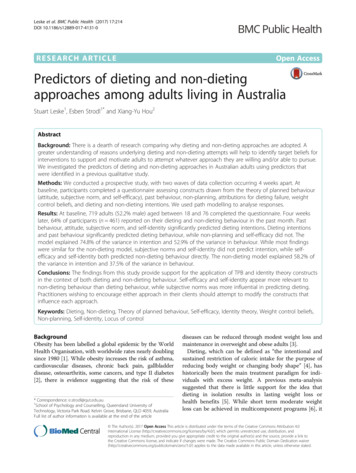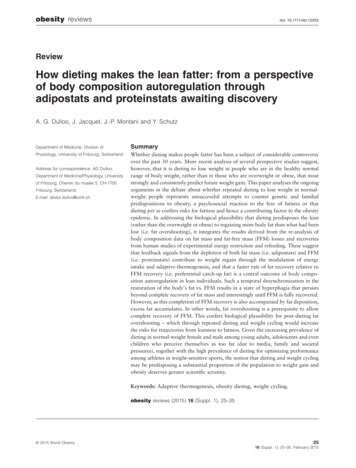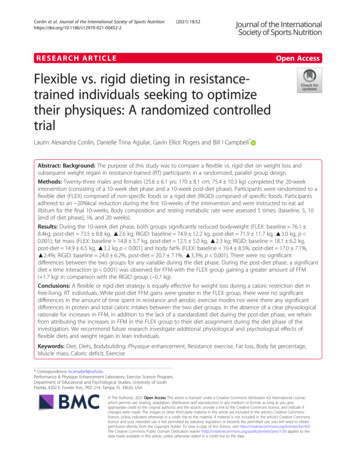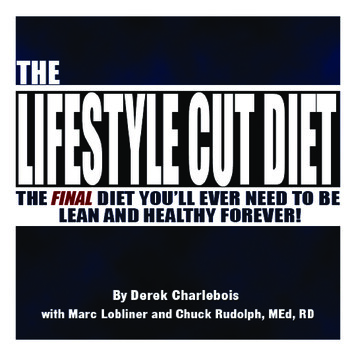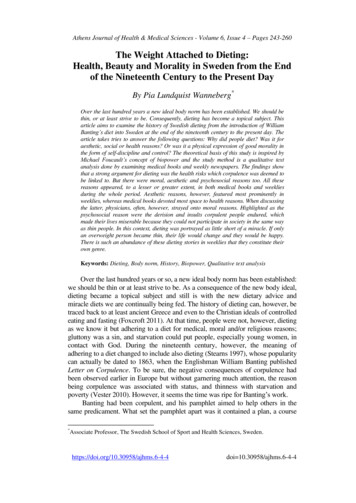
Transcription
Athens Journal of Health & Medical Sciences - Volume 6, Issue 4 – Pages 243-260The Weight Attached to Dieting:Health, Beauty and Morality in Sweden from the Endof the Nineteenth Century to the Present DayBy Pia Lundquist Wanneberg*Over the last hundred years a new ideal body norm has been established. We should bethin, or at least strive to be. Consequently, dieting has become a topical subject. Thisarticle aims to examine the history of Swedish dieting from the introduction of WilliamBanting’s diet into Sweden at the end of the nineteenth century to the present day. Thearticle takes tries to answer the following questions: Why did people diet? Was it foraesthetic, social or health reasons? Or was it a physical expression of good morality inthe form of self-discipline and control? The theoretical basis of this study is inspired byMichael Foucault’s concept of biopower and the study method is a qualitative textanalysis done by examining medical books and weekly newspapers. The findings showthat a strong argument for dieting was the health risks which corpulence was deemed tobe linked to. But there were moral, aesthetic and psychosocial reasons too. All thesereasons appeared, to a lesser or greater extent, in both medical books and weekliesduring the whole period. Aesthetic reasons, however, featured most prominently inweeklies, whereas medical books devoted most space to health reasons. When discussingthe latter, physicians, often, however, strayed onto moral reasons. Highlighted as thepsychosocial reason were the derision and insults corpulent people endured, whichmade their lives miserable because they could not participate in society in the same wayas thin people. In this context, dieting was portrayed as little short of a miracle. If onlyan overweight person became thin, their life would change and they would be happy.There is such an abundance of these dieting stories in weeklies that they constitute theirown genre.Keywords: Dieting, Body norm, History, Biopower, Qualitative text analysisOver the last hundred years or so, a new ideal body norm has been established:we should be thin or at least strive to be. As a consequence of the new body ideal,dieting became a topical subject and still is with the new dietary advice andmiracle diets we are continually being fed. The history of dieting can, however, betraced back to at least ancient Greece and even to the Christian ideals of controlledeating and fasting (Foxcroft 2011). At that time, people were not, however, dietingas we know it but adhering to a diet for medical, moral and/or religious reasons;gluttony was a sin, and starvation could put people, especially young women, incontact with God. During the nineteenth century, however, the meaning ofadhering to a diet changed to include also dieting (Stearns 1997), whose popularitycan actually be dated to 1863, when the Englishman William Banting publishedLetter on Corpulence. To be sure, the negative consequences of corpulence hadbeen observed earlier in Europe but without garnering much attention, the reasonbeing corpulence was associated with status, and thinness with starvation andpoverty (Vester 2010). However, it seems the time was ripe for Banting’s work.Banting had been corpulent, and his pamphlet aimed to help others in thesame predicament. What set the pamphlet apart was it contained a plan, a course*Associate Professor, The Swedish School of Sport and Health Sciences, Sweden.https://doi.org/10.30958/ajhms.6-4-4doi 10.30958/ajhms.6-4-4
Vol. 6, No. 4Wanneberg: The Weight Attached to Dieting of treatment, in which dieting was an end in itself. The course of treatment provedhugely successful, spreading across Europe and to the United States and givingbirth to "dieting," a new word for "weight reduction" (Zweiniger-Bargielowska2010). Nowadays, the notion exists that dieting is particularly a women’s issue,caused by an ever-thinner body ideal, which research has also highlighted (see, forexample, Bordo 1993, Sobel and Maurer 1999, Stinson 2001). However, Banting’starget group was British middle-class men. His course of treatment embraced foodsuch as red meat and alcohol, which were linked to masculinity and economicprosperity. Moreover, the slimmed-down body was in keeping with thecontemporary middle-class male ideals of discipline and self-control. Women weretherefore not initially included; however, middle-class women first becameinvolved when dieting was an established male activity (Vester 2010). It wouldappear that at the turn of the twentieth century working-class women did not sufferfrom obesity; if anything, it was the opposite given the then food tradition, at leastin British working-class homes, where the man as the breadwinner ate first,followed by the children and lastly the woman (Zweiniger-Bargielowska 2010).Banting’s pamphlet, as already mentioned, spread throughout the Westernworld, including Sweden. The question is how was Banting’s concept receivedand developed. The article aims to examine precisely this, with the focus on whydid people diet. Was it for aesthetic, social or health reasons? Or was dieting aphysical expression of good morality in the form of self-discipline and control?Did the reasons change over time and, if so, in what way?Literature SurveyIn international research on dieting, the main focus is on obesity. One suchstudy is Hillel Schwartz’s Never Satisfied: A Cultural History of Diets, Fantasiesand Fat, which has to be regarded as a standard work in the field. The studyspans just over 150 years and examines the American obsession with obesity anddiets in relation to the new body ideal that arose with the growth of theconsumption society at the end of the nineteenth century. Its thesis is that obesitybegan at this time to undergo a transformation, from having indicated esteem andrespect to being regarded as a disease. Since then, the country has seen many dietfads, with dieting having become part of American society (Schwartz 1986).Schwartz sees the growth of, for example, the fashion industry, the marketing ofgoods and services, and medical technology, for instance modern society’sincreasing fixation with measuring things, as the underlying reasons for this. Herepeople’s weight came to serve as an index of character as well as health andbeauty.Obesity in America is also a central theme of Peter N. Stearns’ Fat History:Bodies and Beauty in the Modern West. Stearns, however, makes a comparisonwith France based on America being the most obese nation in the Western worldand France the thinnest. How the French and the Americans viewed obesitychanged during the twentieth century, but their reasons for not being overweightdiffered. While the French were thin for health and beauty reasons, moral aspects244
Athens Journal of Health and Medical SciencesDecember 2019dominated in America (Stearns 1997). Stearns explains the new thinner body idealas being cultural. According to him, only cultural factors, for example theconsumption, beauty and morality culture, can explain how the two countriesdeveloped and differed. He does not, however, discuss what culture is and howcultures are changed.The British author Louise Foxcroft’s book Calories & Corsets: A History ofDieting over 2,000 Years discusses, among other things, diets as well as shortcutsand methods for at least looking thin: everything from corsets and rubberunderwear to laxatives and strychnine (Foxcroft 2011). The long period covered,however, produces a rather general and epic picture of the subject and does notanswer why it was important to look thin or lose weight. A more theory-drivenBritish study is Managing the Body: Beauty, Health and Fitness in Britain, 1880–1939, by Ina Zweiniger-Bargielowska. This study examines training and weightcontrol in relation to the male body’s physical degeneration, deemed to have takenplace at the beginning of the twentieth century and viewed as a threat to Britain’spowerful position (Zweiniger-Bargielowska 2010). The book’s focal point is therelationship between the citizens’ bodies and the bodies the governments wantedto see, which Zweiniger-Bargielowska studied by looking at the health educationcampaigns. For instance, male obesity first needed to be tackled, and not longafter, female obesity.In Swedish studies, too, the focus is more on overweightness and obesity thanon dieting, even though the subject is touched upon. In the study I ett bolster avfett [In a Cushion of Fat], Fredrik Nilsson examines obesity in relation tomasculinity and class, to be more precise an analysis of the transition from arotund peasant ideal to a thinner middle-class variant. Nilsson shows that duringthe nineteenth century overweightness in men was slowly but surely defined as aproblem by principally the medical profession and in medical research but also byvarious social commentators (Nilsson 2011). According to Nilsson, the view wasreinforced in the twentieth-century Swedish welfare state when overweightnesswent from being seen as a middle-class problem to being categorised as a nationaldisease. Not only the government but also organisations were involved in the fightagainst the flab. The 1940s saw the establishment of, for example, FöreningenFetmans Fiender (The Association of the Enemies of Obesity), which, accordingto Nilsson, acted as a national bulwark against the consequences of overweightnessfor the individual and society. The association (active until 2012) focused onphysical activity in the form of, for instance, gymnastics, swimming as well assaunas. Private actors gradually replaced organisations; one well-known exampleis the American company Weight Watchers, which established itself in Sweden inthe 1970s.Obesity, from a societal perspective, is also the theme of Helena Sandberg’sMedier & fetma: en analys av vikt [Media & Obesity: An Analysis of Weight].More specifically, her study examines how overweightness was represented infour Swedish daily newspapers between 1997 and 2001 as well as what values andnorms were produced and reproduced in these newspapers (Sandberg 2004). Thestudy also presents examples of numerous dieting methods in the form ofmedicines, exercises and diets. The findings show, among other things, that245
Vol. 6, No. 4Wanneberg: The Weight Attached to Dieting overweight people were stigmatised, and unlike Banting, who wanted to help hisfellow overweight brethren, even formerly overweight people were involved in thestigmatising. However, overweight men were not described as negatively as theirfemale counterparts; instead, the former’s overweightness and failings wereoverlooked. The newspapers thus did not show this tolerance towards thesewomen, who, instead, were depicted as disgusting, unsuccessful and evendetestable.To sum up, there are some general and more descriptive international historicalstudies on dieting. Of the Swedish studies, only Nilsson’s has a longer historicalperspective, which will be expanded on here to include women. Moreover, a clearerpower perspective on the historical development will be introduced. ZweinigerBargielowska’s study is the only one with both a longer historical perspective and apower perspective. Like this study, it takes Michel Foucault’s concept of biopoweras its theoretical starting point.Power over LifeFor Foucault, power is, as we know, not something absolute that someonepossesses but something exercised. And since it is always exercised within arelationship, power is per definition relational. This goes for important socialrelationships, such as between work and capital or between politicians and voters,as well as at a lower level, for example between men and women, parents andchildren or doctors and patients. We are all involved in countless relationshipswhere power is exercised; we cannot opt out because it is always there. Sincepower is not a resource that resides in a certain position, it is difficult to narrowdown and examine, but it can be acquired through the techniques employed whenit is being exercised. Foucault distinguishes between sovereign power, disciplinarypower and biopower. An important difference between sovereign power andbiopower is that the latter focuses on preserving and protecting life instead oftaking life. Nor does disciplinary power operate through public violence; however,unlike biopower, which targets large groups of people, the individual is the focus.It is the individual who is supervised, controlled and trained to be an obedient andcompliant subject. These various forms of power occurred in different societies,but Foucault is not entirely clear whether they replaced each other. Plausibleinterpretations have been put forward, namely they complement each other by,among other things, operating at different societal levels (see, for example, Liljaand Vinterhagen 2014, Harwood 2009).Typically for Foucault, he links power with the body, which is subjected topainful punishments, discipline and correction or self-disciplining in the form oftraining, dieting or plastic surgery. Because Foucault views power as productive,the body mirrors the power. More specifically, power is, as already mentioned,exercised through various kinds of techniques (acts) to which various technologies(knowledge) are connected. Foucault (1980: 52; as cited in Nilsson 2008) statesthat "it is not possible for power to be exercised without knowledge, it is impossiblefor knowledge not to engender power." In other words, power and knowledge are246
Athens Journal of Health and Medical SciencesDecember 2019intrinsically linked and presuppose each other. However, power, according toFoucault, not only creates knowledge; it also produces individuals who are aproduct of power - how they see and perceive themselves, how they see others andhow they are seen and understood by others. What gives the productivity of powerits legitimacy is that, along with being prohibitive or inhibitory, it also hasadvantages for the individual: better health, living longer, etc. While steering thepopulation towards becoming stronger and more capable, power producessomething perceived as good. The greater freedom we enjoy today does not meanwe are not steered but just differently. Power and freedom are co-constitutive.Biopower, or power over life, is thus a productive power organised aroundnorms that cause an individual’s actions. People’s lives and behaviours areanalysed, controlled and governed by technologies and techniques. However,biopower’s aims are not confined to the individual; it targets the whole of, orsometimes sections of, a population of, for example, a country, an organisation oran institution (Lilja and Vinterhagen 2014). Biopower is seldom exercised directlyby the state but through actors such as doctors, dieticians and gym instructors,rather often as written exercise advice, healthy recipes or recommended checkups. With the scientific knowledge and the administrative techniques these actorshave developed, people’s behaviours and lives are defined, controlled andgoverned. It is an organised influence on behaviour in relation to the objectivesdesigned to improve, for example, our hygiene, level of health and lifespan (Coll2013).In this study, dieting is seen as a technique for regulating and steering people’sbehaviour and lives in a certain direction. The question is in which direction: is ittheir health, morality or something else?Method and Source MaterialThe methodology used is a qualitative text analysis, that is to say, a systematicqualitative analysis of primary data collected from various types of texts (Denzinand Lincoln 2008). In this case, it is qualitative since conceptions, experiences andideas expressed in the collated texts have been observed. Analysing qualitativedata requires an understanding of how to make sense of texts so you can answeryour research questions. Here the analysis has involved a careful reading andrereading of all the material in order to pinpoint the key themes of the texts inrelation to the aim and research questions. In this process, I have first looked forthe texts’ patterns by identifying meaning units in the form of conceptions andideas. The patterns were then aggregated into larger themes (Cresswell 2012).To make sense of the findings, qualitative studies also require a preunderstanding of the examined phenomenon; that is the key to comprehension andinterpretation (Denzin and Lincoln 2008). In this instance, the pre-understanding isprevious research in the field and Foucault’s concept of biopower.This study takes a historical approach. As a historian, you cannot create yourown data, so you have to analyse the available remnants. Here the source materialcomprises medical books, weekly magazines and a health magazine; together they247
Vol. 6, No. 4Wanneberg: The Weight Attached to Dieting span the end of the nineteenth century to the present day. The weekly magazinesare Idun, whose target group was middle-class women, and Året Runt, a familymagazine with a broad readership. Idun was published between 1887 and 1963,when it merged with another magazine. Året Runt was first launched in 1946 andis still in publication. Health magazines are a fairly new phenomenon, but the oneincluded here is Må bra, which first hit the shelves in 1976. It has today thehighest circulation figures of all health magazines in Sweden. Every issue of Idun,Året Runt and Må bra has been examined, starting with their first year ofpublication and then every fifth year.Medical books were used as source material because of the medicalprofession’s increasingly powerful position during this period. Moreover, it isthrough the pages of these books that the medical profession communicates withthe public. I have examined all Swedish-language medical books that during thisperiod discussed dieting. The weekly magazines and the health magazine areimportant source material for finding out what was being debated in Swedishsociety and in what way. The media convey values and attitudes and inform us ofwhat is expected of us and what we can expect of others. The media can be said toact as a compass - rather often a moral one - that helps us navigate life. Nowadayswe talk about mediated experiences, that is to say, ones we have acquired from themedia and made into our own when we have no personal experience of the subjectin question (Thompson 1995, Cotter 2001). So even if the reader has never beenoverweight or dieted, they can acquire through the media both experiences of thesubject and an idea of what we can expect of people who are overweight and/ordieting.The FindingsHow Banting Was Received in SwedenBanting, 65 years old when Letter on Corpulence was published, had, in hisown words, long suffered from obesity, which had hugely affected his life. Forexample, he had been unable to take off his shoes, stoop or go down the stepsnormally; instead, he had to go down backwards, an exertion causing him to sweatprofusely and become seriously out of breath. Moreover, when in traincompartments and theatre auditoriums, he felt he terrified those around him.Preferring to stay at home than to be ridiculed and scorned, he became sociallyisolated and low-spirited: "Of all the parasites that affect humanity I do not knowof, nor can I imagine, any more distressing than that of Obesity" (Banting 1864).Banting had made numerous attempts to lose weight. He had tried to bephysically active and had taken various kinds of baths believed to have weightreducing effects. He had also sought the advice of many eminent physicians in thisfield, but without any luck. Help came from an unexpected quarter, from an ear,nose and throat specialist named William Harvey. Banting’s hearing haddeteriorated; hence, he consulted Harvey, who felt Banting’s deafness was linkedto his corpulence. He prescribed the diet that Banting reproduces in Letter on248
Athens Journal of Health and Medical SciencesDecember 2019Corpulence. Harvey’s source of inspiration for this diet was a lecture he had heardthe French physiologist Claude Bernard give on the role liver played in cases ofdiabetes. Bernard believed that, apart from secreting bile, the liver producedsomething that helped to break down sugar. Harvey began to examine how variouskinds of food, including carbohydrates, affected the body (Gilman 2008). Areduction in carbohydrates was central to the diet Banting was on: carbohydratefoods, such as bread, sugar and potatoes, were eliminated as were beer and milk.Instead, his meals consisted principally of meat but also fish, vegetables as well asservings of wine, sherry or Madeira to accompany his lunches and dinners.Banting claimed that thanks to this diet he had lost in the first year 46 pounds(approx. 21 kilos). His health and his life in general had, also according to himself,considerably improved (Banting 1864, Gilman 2008).In 1864, Banting’s pamphlet, published the previous year, was the subject of aletter printed in a Swedish newspaper. The letter described, praised and criticisedhis method. The writer, who himself suffered from corpulence, had givenBanting’s diet a go for a month. Thanks to his endeavours, he felt "fleeter of foot"for the first time in twenty years, he no longer needed a siesta, he felt young againand had lost weight. But, he wondered, was it really possible to equate weight withhealth? Might the huge meat intake, combined with a reduced fat intake, create anunhealthy imbalance in the body? He also questioned the large quantities ofalcohol that were part of the treatment; besides wine with every meal, he took awhisky nightcap. Could the health benefit that a weight reduction might bringcompensate for what was verging on drunkenness (Post-och Inrikes Tidningar1864)?Two years later, in 1866, Letter on Corpulence was translated into Swedishby Edward Edholm, physician and member of the Royal Medical Board. In 1880,Edholm evaluated the method, which, in his opinion, had been well-received bythe medical profession and the general public, both in Sweden and abroad. Thequestion "Do you bant?" entered public discourse in England just like the verb"banta" did in Sweden. Edholm himself was wholly in favour of the method andwished to help spread the word. One thing Edholm very much liked to emphasisewas that Banting’s treatment was based on science, and he immersed himself in,and described in detail, the chemical and physiological processes involved whenfollowing the diet and which foods were suitable and unsuitable when doing so(Edholm 1880).Why then, according to Edholm, should people diet? He listed many reasons,but the main ones were health-related. Overfatness, known as morbidly obese, wasassociated with a number of health risks, principally due to the fat deposits not justbetween the skin and the muscles but also in the inner muscles, arteries andorgans. All the fat made it harder for the heart to pump the blood around the body,and with fat also pressed up into the thoracic cavity, the lungs were negativelyaffected as well. Consequently, the sufferer had palpitations, difficulty breathingand chest pressure as well as bad eyesight and hearing problems. In fact, no bodypart was unaffected. In the case of women, who, according to Edholm, were moreinclined to be obese than men, even their reproductive organs were affected, whichcould cause hysteria and sterility. The prognosis was bleak for obese people:249
Vol. 6, No. 4Wanneberg: The Weight Attached to Dieting "Afflicted with these troublesome symptoms, overfat people live a wretchedexistence until a supervening disease or the rampancy of overfatness ends theirsuffering." (Edholm 1880: 42; my translation)Besides health reasons, Edholm put forward other reasons why obese peopleshould diet. One was aesthetic-related. For, according to Edholm, obese people’sbody parts were not in harmony. The slender and curved contours, which, in hisopinion, were the foundations of health and beauty, were instead bulky andunsymmetrical. For example, the head was either flushed or, like the rest of theskin, "pale, flabby and puffy." With the throat covered by a thick layer of fat, thechest looked thinner than usual, and the lower abdomen protruded, which, in turn,affected the person’s gait in an unflattering way (Edholm 1880). Edholm’s notionsabout equating beauty with a harmonious body can be traced back to that period’snatural philosophical notion of interconnectedness. Because a human being ismade up of a number of parts, it could not be completely whole; the wholenessdepended on the relationship between body parts. Being in harmony was a sign ofboth beauty and health, and disharmony the opposite (Ljunggren 1999). As forEdholm, who, of course, was a physician, the health reasons he gave for dietingwere probably linked to the natural scientific ideals, but he shared the aestheticnotion held by the nature romanticists, namely obesity meant a departure from theideal of the harmonious whole and was therefore ugly.The other reasons Edholm gave for dieting were moral-related. He describedthree real-life cases designed to be inspiring and edifying: three overweightSwedish men who had lost weight thanks to Banting’s treatment. In the casedescriptions, he emphasises the effort of will and the firmness of character that hadproduced the successful results. On the other hand, he described those who failedto complete the treatment as weak people undeserving of compassion. They hadonly themselves to blame if they were ridiculed and parodied. The three men alsodemonstrated a scientifically critical approach to their dieting insofar as they testedvarious foods to see whether they put on or lost weight. They added a few glassesof beer a week, then weighed themselves; they slightly reduced the number ofglasses and weighed themselves again (Edholm 1880). Taking a scientificapproach to dieting appears almost as important as the actual weight reduction.The three cases are interesting from another perspective. According toEdholm, he had chosen to publish these very cases because they wererepresentative and served as good examples for those wanting to lose weight.Interestingly enough, they are all middle-aged, middle-class men. Besides, asshown above, women’s specific obesity problems, Edholm makes no mentionwhatsoever of women. As for other social classes, he noted that farmers andcraftsmen were thin even though they ate copious amounts due to the heavy workthey did, and although the poor, working-class population’s food was mainly,according to Banting’s treatment, unsuitable, such as bread, potatoes, milk andporridge, this group rarely had overweight people (Edholm 1880).Banting’s treatment thus appears to have aroused the interest of middle-classSwedish men even though the diet came in for some criticism. Above all, healthreasons, but also moral and aesthetic ones, were given for why people should diet.250
Athens Journal of Health and Medical SciencesDecember 2019These reasons were to continue to be invoked. However, Edholm fails to give theperhaps most prominent reasons advanced by Banting himself: the psychosocialones. For Banting, his corpulence had caused him to become isolated because ofthe ridicule received and the problems he had getting around outside. This willalso be further examined later in the article."The Fat Person is digging their own Grave with their Teeth"From having been a sign of good health, obesity, as already mentioned, beganto gradually be viewed as a disease, meaning it was the physician’s job to diagnoseand treat the condition. At the turn of the twentieth century, physicians categorisedobesity into two types based on a difference of degree: morbid obesity, known asoverfatness, and non-morbid obesity, known as corpulence. Three criteria wereused to ascertain whether a person suffered from morbid obesity. The first oneconcerned their appearance: that the person in question’s body size and girthharmed the body’s proportions. A large weight increase was only the secondcriterion, and the third was the functional changes of certain organs. To bediagnosed as overfat, the patient had to fulfil all three criteria (Pfannenstill 1901).However, gradually a person’s weight in kilos, followed by their body mass index(BMI) and then their waist and belly size, determined whether they were overfat.For example, a person’s BMI is used today as a criterion for determining whetherthey receive a gastric bypass (Lagerlöf 1958, Hasselgren 2013). Defining aperson’s condition does not appear to have been that easy. During the researchperiod, the medical books interchangeably used the terms overfatness, obesity,morbid obesity and corpulence to describe the condition, with obesity being themost common.Just as with Edholm, the medical profession held the view throughout theresearch period that obesity could cause numerous minor and seriouscomplications. What changed over time, however, was how obesity was viewed,and, from a health perspective, what it caused. The medical books warned that anoverweight person who did not tackle this and go on a diet could be afflicted withcomplaints, such as flat-footedness, articular cartilage damage in the knees andvaricose veins, thus causing the person pain, which, in turn, restricted theirmobility, as a result of which they could put on some extra kilos. Moreover, thepatient could exhibit eczema-like changes in the rolls of fat but also seriousdiseases, such as heart problems, a stroke and cancer (Sjövall 1953, Dickstone1948, Åberg, 2005, Hasselgren 2013). This was quite clearly linked to the manydangers of being overweight, or as one physician in the 1950s put it: "The fatperson is digging their own grave with their teeth" (Sjövall 1953: 91; mytranslation).At the beginning of the 1950s, at any rate, dieting had in Swedish societyspread from middle-class men to other social classes and women. The mediaobserved at the time that increased prosperity had resulted in the Swedishpopulation getting fatter. A survey cond
Vol. 6, No. 4 Wanneberg: The Weight Attached to Dieting 244 of treatment, in which dieting was an end in itself. The course of treatment proved hugely successful, spreading across Europe and to the United States and giving birth to "dieting," a new w
